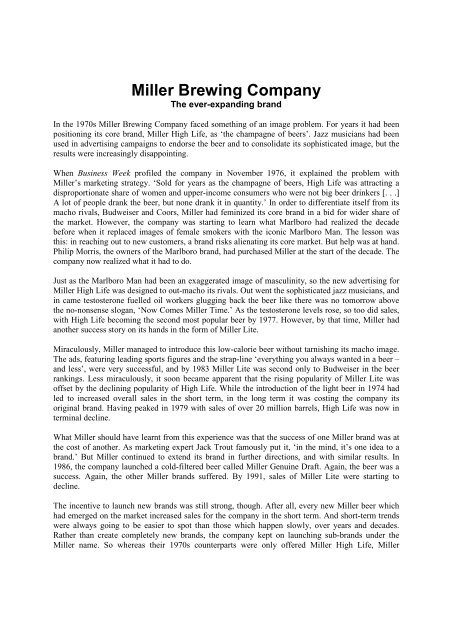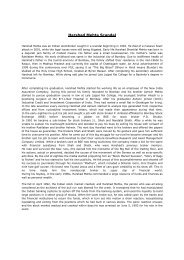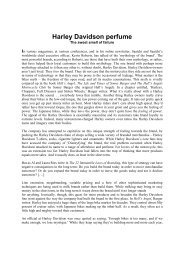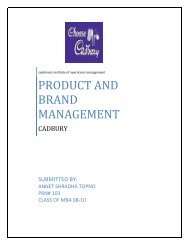Miller Brewing Company - CaseStudy.co.in
Miller Brewing Company - CaseStudy.co.in
Miller Brewing Company - CaseStudy.co.in
You also want an ePaper? Increase the reach of your titles
YUMPU automatically turns print PDFs into web optimized ePapers that Google loves.
<strong>Miller</strong> <strong>Brew<strong>in</strong>g</strong> <strong>Company</strong><br />
The ever-expand<strong>in</strong>g brand<br />
In the 1970s <strong>Miller</strong> <strong>Brew<strong>in</strong>g</strong> <strong>Company</strong> faced someth<strong>in</strong>g of an image problem. For years it had been<br />
position<strong>in</strong>g its <strong>co</strong>re brand, <strong>Miller</strong> High Life, as ‘the champagne of beers’. Jazz musicians had been<br />
used <strong>in</strong> advertis<strong>in</strong>g campaigns to endorse the beer and to <strong>co</strong>nsolidate its sophisticated image, but the<br />
results were <strong>in</strong>creas<strong>in</strong>gly disappo<strong>in</strong>t<strong>in</strong>g.<br />
When Bus<strong>in</strong>ess Week profiled the <strong>co</strong>mpany <strong>in</strong> November 1976, it expla<strong>in</strong>ed the problem with<br />
<strong>Miller</strong>’s market<strong>in</strong>g strategy. ‘Sold for years as the champagne of beers, High Life was attract<strong>in</strong>g a<br />
disproportionate share of women and upper-<strong>in</strong><strong>co</strong>me <strong>co</strong>nsumers who were not big beer dr<strong>in</strong>kers [. . .]<br />
A lot of people drank the beer, but none drank it <strong>in</strong> quantity.’ In order to differentiate itself from its<br />
macho rivals, Budweiser and Coors, <strong>Miller</strong> had fem<strong>in</strong>ized its <strong>co</strong>re brand <strong>in</strong> a bid for wider share of<br />
the market. However, the <strong>co</strong>mpany was start<strong>in</strong>g to learn what Marlboro had realized the decade<br />
before when it replaced images of female smokers with the i<strong>co</strong>nic Marlboro Man. The lesson was<br />
this: <strong>in</strong> reach<strong>in</strong>g out to new customers, a brand risks alienat<strong>in</strong>g its <strong>co</strong>re market. But help was at hand.<br />
Philip Morris, the owners of the Marlboro brand, had purchased <strong>Miller</strong> at the start of the decade. The<br />
<strong>co</strong>mpany now realized what it had to do.<br />
Just as the Marlboro Man had been an exaggerated image of mascul<strong>in</strong>ity, so the new advertis<strong>in</strong>g for<br />
<strong>Miller</strong> High Life was designed to out-macho its rivals. Out went the sophisticated jazz musicians, and<br />
<strong>in</strong> came testosterone fuelled oil workers glugg<strong>in</strong>g back the beer like there was no tomorrow above<br />
the no-nonsense slogan, ‘Now Comes <strong>Miller</strong> Time.’ As the testosterone levels rose, so too did sales,<br />
with High Life be<strong>co</strong>m<strong>in</strong>g the se<strong>co</strong>nd most popular beer by 1977. However, by that time, <strong>Miller</strong> had<br />
another success story on its hands <strong>in</strong> the form of <strong>Miller</strong> Lite.<br />
Miraculously, <strong>Miller</strong> managed to <strong>in</strong>troduce this low-calorie beer without tarnish<strong>in</strong>g its macho image.<br />
The ads, featur<strong>in</strong>g lead<strong>in</strong>g sports figures and the strap-l<strong>in</strong>e ‘everyth<strong>in</strong>g you always wanted <strong>in</strong> a beer –<br />
and less’, were very successful, and by 1983 <strong>Miller</strong> Lite was se<strong>co</strong>nd only to Budweiser <strong>in</strong> the beer<br />
rank<strong>in</strong>gs. Less miraculously, it soon became apparent that the ris<strong>in</strong>g popularity of <strong>Miller</strong> Lite was<br />
offset by the decl<strong>in</strong><strong>in</strong>g popularity of High Life. While the <strong>in</strong>troduction of the light beer <strong>in</strong> 1974 had<br />
led to <strong>in</strong>creased overall sales <strong>in</strong> the short term, <strong>in</strong> the long term it was <strong>co</strong>st<strong>in</strong>g the <strong>co</strong>mpany its<br />
orig<strong>in</strong>al brand. Hav<strong>in</strong>g peaked <strong>in</strong> 1979 with sales of over 20 million barrels, High Life was now <strong>in</strong><br />
term<strong>in</strong>al decl<strong>in</strong>e.<br />
What <strong>Miller</strong> should have learnt from this experience was that the success of one <strong>Miller</strong> brand was at<br />
the <strong>co</strong>st of another. As market<strong>in</strong>g expert Jack Trout famously put it, ‘<strong>in</strong> the m<strong>in</strong>d, it’s one idea to a<br />
brand.’ But <strong>Miller</strong> <strong>co</strong>nt<strong>in</strong>ued to extend its brand <strong>in</strong> further directions, and with similar results. In<br />
1986, the <strong>co</strong>mpany launched a <strong>co</strong>ld-filtered beer called <strong>Miller</strong> Genu<strong>in</strong>e Draft. Aga<strong>in</strong>, the beer was a<br />
success. Aga<strong>in</strong>, the other <strong>Miller</strong> brands suffered. By 1991, sales of <strong>Miller</strong> Lite were start<strong>in</strong>g to<br />
decl<strong>in</strong>e.<br />
The <strong>in</strong>centive to launch new brands was still strong, though. After all, every new <strong>Miller</strong> beer which<br />
had emerged on the market <strong>in</strong>creased sales for the <strong>co</strong>mpany <strong>in</strong> the short term. And short-term trends<br />
were always go<strong>in</strong>g to be easier to spot than those which happen slowly, over years and decades.<br />
Rather than create <strong>co</strong>mpletely new brands, the <strong>co</strong>mpany kept on launch<strong>in</strong>g sub-brands under the<br />
<strong>Miller</strong> name. So whereas their 1970s <strong>co</strong>unterparts were only offered <strong>Miller</strong> High Life, <strong>Miller</strong>
dr<strong>in</strong>kers <strong>in</strong> the 1990s had <strong>co</strong>nsiderably more choice. Walk<strong>in</strong>g <strong>in</strong>to a bar or supermarket, they not only<br />
had to choose between <strong>Miller</strong>, Coors and Budweiser, but between various brands with<strong>in</strong> the<br />
<strong>Miller</strong> range itself.<br />
There was still <strong>Miller</strong> High Life (hang<strong>in</strong>g on by a thread) and <strong>Miller</strong> Lite, but also <strong>Miller</strong> Lite Ice,<br />
<strong>Miller</strong> High Life Lite, <strong>Miller</strong> Genu<strong>in</strong>e Draft, <strong>Miller</strong> Genu<strong>in</strong>e Draft Lite, <strong>Miller</strong> Reserve, <strong>Miller</strong><br />
Reserve Lite, <strong>Miller</strong> Reserve Amber Ale and the very short-lived <strong>Miller</strong> Clear. The trouble was not<br />
so much that there were too many <strong>Miller</strong> brands (although that was <strong>in</strong>deed a problem) but that they<br />
were variations of each other, rather than a variation of one <strong>co</strong>re brand. (Incidentally, this theory<br />
expla<strong>in</strong>s why Diet Coke succeeded where New Coke failed. Whereas the former had supplemented<br />
the orig<strong>in</strong>al brand, the latter had eradicated it <strong>co</strong>mpletely.)<br />
In 1996 <strong>Miller</strong> decided to address this situation, add<strong>in</strong>g yet another brand to the mix, <strong>Miller</strong> Regular.<br />
The <strong>co</strong>mpany had looked at the success of its rivals’ regular beers and wanted a piece of the action.<br />
In other words, they wanted a beer which would <strong>co</strong>me to represent everyth<strong>in</strong>g <strong>Miller</strong> stood for,<br />
which by that po<strong>in</strong>t was rather a lot. The only problem was that with so many <strong>Miller</strong> brands already<br />
out there, launch<strong>in</strong>g another one (even with a US $50 million market<strong>in</strong>g budget) was always go<strong>in</strong>g to<br />
be a challenge, especially when it had such an unassum<strong>in</strong>g name. With an apparently limitless array<br />
of <strong>Miller</strong>s to choose from, most people assumed that <strong>Miller</strong> Regular had always been there. As a<br />
result, the brand failed to make an impact and <strong>Miller</strong> eventually decided to withdraw it altogether.<br />
The problem of identity, however, still rema<strong>in</strong>ed. Whereas dr<strong>in</strong>kers <strong>co</strong>uld go <strong>in</strong>to a bar and say to the<br />
bartender, ‘I’ll have a Budweiser,’ caus<strong>in</strong>g little <strong>co</strong>nfusion, if they said, ‘I’ll have a <strong>Miller</strong>,’ the<br />
bartender would <strong>in</strong>evitably ask, ‘Which <strong>Miller</strong>?’<br />
As Jack Trout wrote <strong>in</strong> his excellent and <strong>in</strong>fluential book, The New Position<strong>in</strong>g, ‘the more variations<br />
you attach to the brand, the more the m<strong>in</strong>d loses focus.’ <strong>Miller</strong> hadn’t just alienated its <strong>co</strong>re<br />
customers, it had <strong>co</strong>mpletely baffled them. Whereas <strong>in</strong> the 1970s <strong>Miller</strong> had achieved its success by<br />
tighten<strong>in</strong>g its focus, by the time the <strong>co</strong>mpany had reached the new millennium it had broadened itself<br />
beyond re<strong>co</strong>gnition. While <strong>Miller</strong>’s long-stand<strong>in</strong>g rival, Budweiser, has now taken its regular brand<br />
identity to new levels of simplicity (reflected <strong>in</strong> the one-word strap l<strong>in</strong>e, ‘True’), <strong>Miller</strong> still suffers<br />
from a lack of <strong>co</strong>herence. So, although the beer itself may taste great, the brand has def<strong>in</strong>itely<br />
be<strong>co</strong>me watered down.
Lessons from <strong>Miller</strong><br />
Don’t extend your brand too far. ‘Leverage is good, too much leverage is bad,’ says brand guru<br />
Tom Peters. He is jo<strong>in</strong>ed <strong>in</strong> this op<strong>in</strong>ion by Al Ries and Jack Trout, for whom ‘The Law of L<strong>in</strong>e<br />
Extension’ is one of ‘The 22 Immutable Laws of Market<strong>in</strong>g.’ This law states, ‘if you want to be<br />
successful today, you have to narrow the focus <strong>in</strong> order to build a position <strong>in</strong> the prospect’s m<strong>in</strong>d.’<br />
Have a <strong>co</strong>re brand. While Ries and Trout are right to highlight the potential problems of l<strong>in</strong>e<br />
extension, it is important to differentiate between those <strong>co</strong>mpanies that can get away with it, and<br />
those that can’t. Brand extensions aren’t bad <strong>in</strong> themselves. For <strong>in</strong>stance, nobody <strong>in</strong> his or her right<br />
m<strong>in</strong>d would call Diet Coke a bad brand<strong>in</strong>g decision. Even <strong>Miller</strong>’s chief <strong>co</strong>mpetitors have played the<br />
extension game. In some respects, Budweiser is as guilty as <strong>Miller</strong> at broaden<strong>in</strong>g its l<strong>in</strong>e (<strong>co</strong>nsider<br />
Bud Light, Bud Dry and Bud Ice, for example), but unlike <strong>Miller</strong>, it has a <strong>co</strong>re brand, Budweiser<br />
itself. <strong>Miller</strong>, on the other hand, has merely be<strong>co</strong>me the sum of its many parts. By the time the<br />
<strong>co</strong>mpany tried to rectify the situation, with the launch of <strong>Miller</strong> Regular <strong>in</strong> 1996, it had left it too late.<br />
Learn from your mistakes. <strong>Miller</strong> was clearly too focused on the success of each new brand it<br />
created to understand the negative impact these new brands were hav<strong>in</strong>g on its exist<strong>in</strong>g beers.<br />
Change your brand name. Although <strong>Miller</strong> was launch<strong>in</strong>g new brands, it kept hold of the ‘<strong>Miller</strong>’<br />
name. If the <strong>co</strong>mpany had created <strong>co</strong>mpletely new names for each range, there would have been less<br />
<strong>co</strong>nsumer <strong>co</strong>nfusion.









